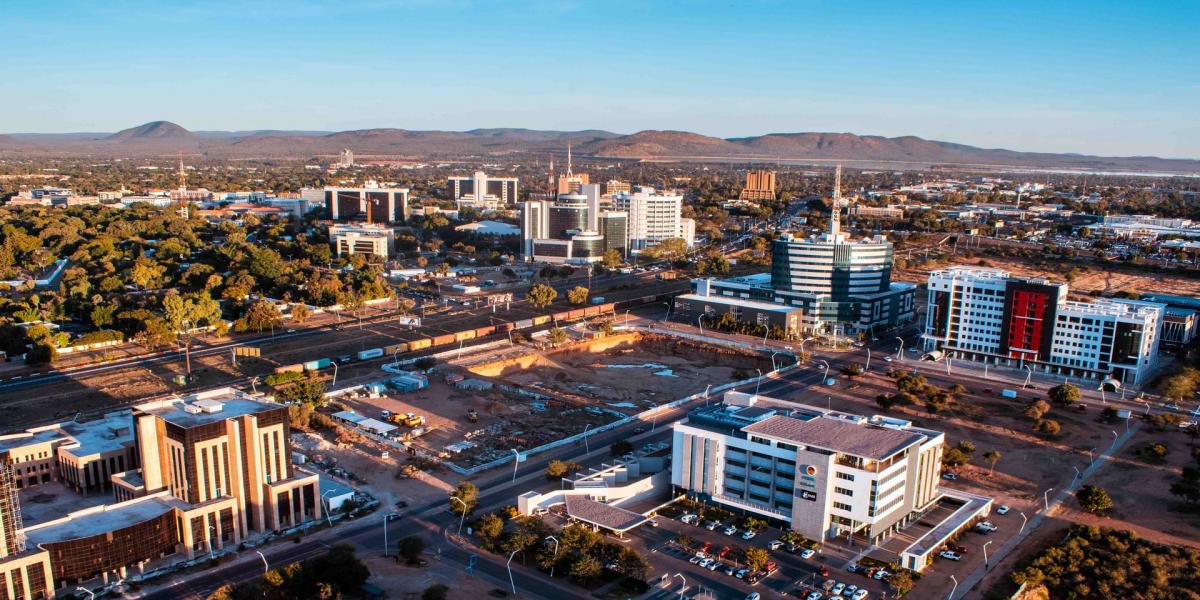Gaborone is a buzzing and growing city, after Kgosi Gaborone, leader of the Batlokwa people, who migrated from their ancestral homelands in the Magaliesberg Mountains and settled in the Tlokweng area in 1881. Gaborone literally means 'it does not fit badly' or 'it is not unbecoming'.
Gaborone's tolerant mindset derives from gathering the many different cultures and thousands-strong individual minds. The capital city boasts a range of hotels and a choice of cinemas and casinos. Restaurants are numerous and varied, and nightclubs and venues often host live music by local and regional artists. The National Museum is situated near the old town's centre, housing essential collections of traditional crafts and southern African fine art.
Gaborone is no different from any other city, with the western trappings of urban life. Still, as soon as you leave the city and its main roads, you walk into another world. The silence takes your breath away as you enter rural Africa within minutes.
Three Chiefs Monument
Crossing the railway tracks into a recently developed Central Business District, the Three Chiefs' Monument is an impressive statue that marks a significant turning point in Botswana's history. In the late 1800s, Botswana territory was under threat from British industrialist Cecil Rhodes. He wished to take over Bechuanaland for his British South Africa Company. Three senior chiefs of the time – Chief Khama III of the Bangwato, Chief Sebele I of the Bakwena, and Chief Bathoen I of the Bangwaketse – travelled to London in 1885 to petition Joseph Chamberlain, Secretary of State for the Colonies. Whilst there, they were also presented to Queen Victoria. Gaining support from the British public, they petitioned the Queen for protection, which was granted. The Bechuanaland Protectorate was established in the same year, circumventing the territory's potentially disastrous incorporation into the British South Africa Company, and forever altering the country's history. The monument was sculpted and cast by North Korean artisans, using a photograph of the three chiefs. It was unveiled on the occasion of the country's 39th anniversary of independence in 2005. Visitors to the monument receive a guided tour from a local historian.
University of Botswana
Across the road from the National Stadium is Botswana's first institution of higher education. Established in 1982, the University of Botswana has been directly involved in national development. Today the university, referred to with much admiration by locals as "Mma-Dikolo" (Mother of Universities), boasts nine faculties and a school for graduates. Notable alumni include judge, human rights activists and writer Unity Dow, statesman and politician Duma Boko, who also lectured there for ten years and not forgetting Zimbabwean lawyer, internationally recognised for her defence of journalists and press freedom, Beatrice Mtetwa.
Thapong Visual Arts Centre
Situated in the former magistrate's house (1902), the Thapong Visual Arts Centre is home to Botswana's young, gifted – and sometimes avant-garde – artists. In addition to regular exhibitions, this very active centre also periodically offers children's art courses.
The site is also home to The No. 1 Ladies Coffee House, named after Alexander McCall Smith's novel series 'The Number One Ladies Detective Agency'. A quaint, art-filled restaurant filled with charm and innovative treats and its ambience makes it the perfect accompaniment to Thapong Arts Centre.
Enquire at their offices to schedule upcoming activities or check the local newspapers. For details Tel: +267 316-1771.
Gaborone Game Reserve
Possibly one of the few national reserves to be situated inside a city, this relatively small (5 square km) but well-stocked park is home to several of Botswana's indigenous species, including zebra, eland, gemsbok, red hartebeest, blue wildebeest, impala, kudu, steenbok, vervet monkeys, warthog and rock dassies, as well as numerous resident and migrant bird species, best viewed from the small dam in the park. The terrain includes tree savanna, riparian woodland, marsh and rocky outcrops, making it a popular destination for day visits and picnics. There are animal and bird-watching-hides and a visitors' centre, with educational tours available for school children and other visitors if pre-booked.













